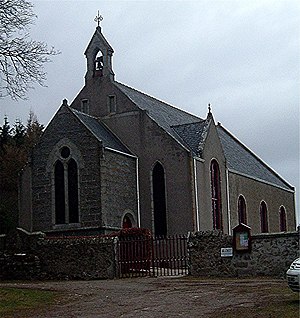31:
55:
Thronach unknown). Pressendye – the highest hill that overlooks
Cushnie at 619 metres – does not appear to be of Gaelic origin and its true meaning is unknown. It may derive from Pictish, which is an extinct Brittonic language that is related to Welsh and was spoken in the Northeast of Scotland until around the 11th century, being gradually replaced by Scottish Gaelic with the expansion of
47:
that much of the Parish sits at around 1,000 ft above sea level and experiences harsh winters. Another possible theory according to
Alexander Smith in 'A New History of Aberdeenshire' is that it comes from the Celtic Ch'oisinn, or Ch'oisne, which means the "corner or angle" of the country, as Dal or Daile-choisne, in Perthshire, means "the field at the corner or angle."
38:
extreme length in a direct line, from the
Tarland boundary, near Tilly-lodge, to the top of Coiliochbhar on the north, is about 5¾ miles, and the distance, from the Tough boundary on the east, to the top of the hill of Cushnie on the west, is nearly seven miles. The whole area is computed to be 12,859 acres, 448 decs.
46:
Cushnie over the centuries has been spelt
Cussenin, Cusschene, Cusseny, Cuischnie, Cusney, and Cushney. It is pronounced locally with the 'U' as in 'cUsp'. There are several theories as to the origin of this name. One being that it derives from the Gaelic 'Cuisneach' meaning the frosty place – given
59:
and the unification of the
Scottish kingdom. Scots Gaelic in turn was replaced by lowland Scots English or 'Doric', in this area of Aberdeenshire around the 16th and 17th centuries. By the time of the Statistical Accounts of Cushnie in 1792, it is stated "English is the only language known in the
50:
In ancient documents, Leochel is spelt
Loychel, Loquhell, Lochel, Lochale, Leuchell, and Leochel. It is pronounced phonetically 'LUKEL.' According to Alexander Smith "the name is derived from the Celtic Lia, which signifies grey, and with the compound word uichill, a very common construction of
54:
Many of the place names in
Leochel-Cushnie are of Scottish Gaelic origin including Balnakeilly (Baile-na-coille), "the town of the wood"; Balchimmy "the town of combing wool"; The Socach; "the snout or beak" Coiliochbhar "the wooded point or hill" and Alt Thronach "Stream or burn" (meaning of
37:
The old parishes of
Leochel and Cushnie were united in 1795, on the death of Mr. Francis Adam, minister of Cushnie. The parish is bounded on the north by Kildrummy and Alford; on the east by Tough and Lumphanan; on the south by Coull, Tarland, and Logie-Coldstone; and on the west by Towie. The
51:
Uch-dach-M'hill, meaning "prominent hills," we have Lia-uich-ill, the "grey prominent hills," which are very descriptive of the parish, and the derivation has every degree of probability.
176:
120:
233:
24:
180:
56:
98:, Bishop of Caithness, died at Craigievar, Aberdeenshire, in October 1668, and was buried in Leochel church, in the Craigievar aisle.
89:
95:
248:
101:
223:
202:
73:
80:'s archaeology service believed it to be real and ceased research after the former owner informed them.
30:
107:
69:
77:
8:
110:, a Scottish-Australian Presbyterian minister and educator, born 1813 in Leochel-Cushnie.
104:(1593–1648), a Scottish minister and theologian, was buried in the churchyard of Leochel.
177:"Ancient stone circle in Aberdeenshire revealed to be modern fake – the Scotsman"
228:
242:
139:
The
Cairngorm Club Journal 044 – The Hill of Cushnie – Robert Anderson (1915)
72:" was revealed to have been constructed by a former farm owner in the 1990s.
20:
92:(1841–1879), a British Army doctor. He was born at Leochel Cushnie.
203:"'Ancient' Aberdeenshire stone circle found to be replica"
121:
List of listed buildings in
Leochel-Cushnie, Aberdeenshire
157:
A New History of Aberdeenshire – Alexander Smith (1875)
148:
A New History of Aberdeenshire – Alexander Smith (1875)
60:
parish, the Gaelic having ceased to be understood".
240:
166:The Statistical Accounts of Scotland (1791–1845)
25:West Aberdeenshire (UK Parliament constituency)
68:In January 2019 a supposedly ancient local "
29:
241:
23:, about 40 km west of Aberdeen (
13:
14:
260:
217:
83:
63:
195:
169:
160:
151:
142:
133:
1:
224:FamilySearch description page
126:
74:Historic Environment Scotland
41:
7:
114:
10:
265:
249:Geography of Aberdeenshire
108:James Forbes (minister)
70:recumbent stone circle
34:
78:Aberdeenshire Council
33:
229:Old map and history
209:. 21 January 2019.
183:on 22 January 2019
35:
256:
211:
210:
199:
193:
192:
190:
188:
179:. Archived from
173:
167:
164:
158:
155:
149:
146:
140:
137:
264:
263:
259:
258:
257:
255:
254:
253:
239:
238:
220:
215:
214:
201:
200:
196:
186:
184:
175:
174:
170:
165:
161:
156:
152:
147:
143:
138:
134:
129:
117:
86:
66:
44:
19:is a parish in
17:Leochel-Cushnie
12:
11:
5:
262:
252:
251:
237:
236:
234:Church details
231:
226:
219:
218:External links
216:
213:
212:
194:
168:
159:
150:
141:
131:
130:
128:
125:
124:
123:
116:
113:
112:
111:
105:
99:
96:Patrick Forbes
93:
90:Peter Shepherd
85:
84:Notable people
82:
65:
62:
43:
40:
9:
6:
4:
3:
2:
261:
250:
247:
246:
244:
235:
232:
230:
227:
225:
222:
221:
208:
204:
198:
182:
178:
172:
163:
154:
145:
136:
132:
122:
119:
118:
109:
106:
103:
100:
97:
94:
91:
88:
87:
81:
79:
75:
71:
61:
58:
52:
48:
39:
32:
28:
26:
22:
21:Aberdeenshire
18:
206:
197:
185:. Retrieved
181:the original
171:
162:
153:
144:
135:
67:
64:Stone circle
53:
49:
45:
36:
16:
15:
102:John Forbes
187:21 January
127:References
57:Dàl Riada
42:Etymology
243:Category
207:BBC News
115:See also
189:2019
76:and
27:).
245::
205:.
191:.
Text is available under the Creative Commons Attribution-ShareAlike License. Additional terms may apply.
